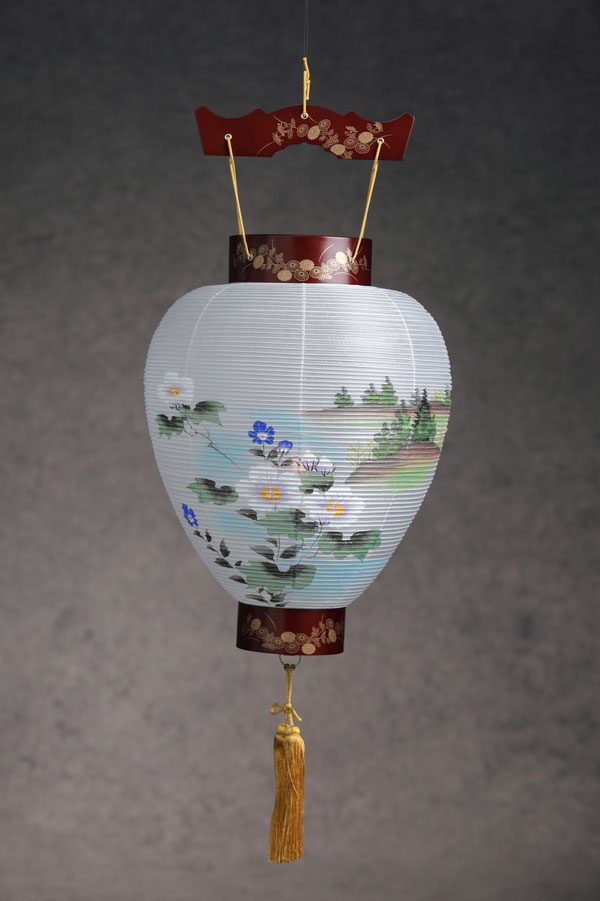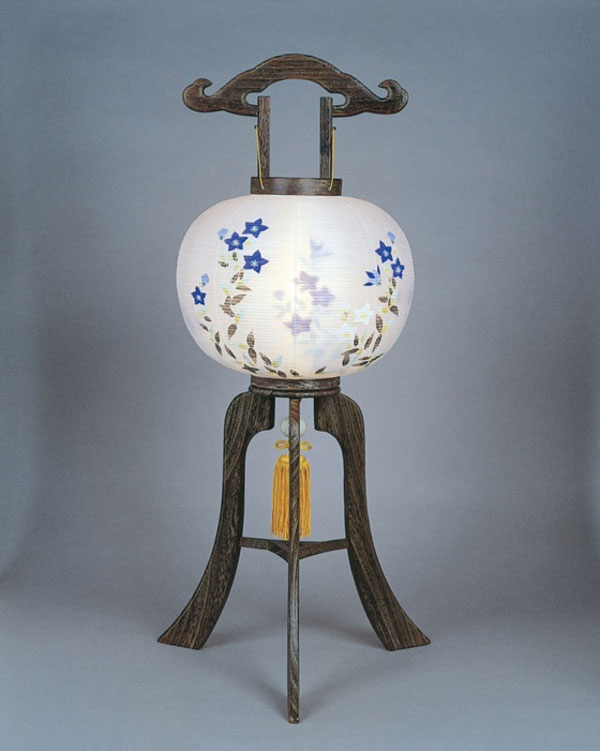 Photo:Gifu City
Photo:Gifu City
- Other crafts
- Gifu
Gifu lanterns Gifu chochin
Graceful & delicate shape
Elegant & immaculate design
Description
What is Gifu lanterns ?
Gifu lanterns (called Gifu chochin in Japanese) are produced in the city of Gifu, Gifu prefecture and have a history of over three hundred years. In 1995, their high level of craftsmanship was recognized with a designation as a National Traditional Craft.
These lanterns are used as household decoration during the Obon Festival (a Japanese Buddhist custom to honor the spirits of one's ancestors) which occurs in the summer. They are also used for lighting and interior design.
The quintessential Gifu lantern, called gosho, is oval-shaped and hanged for use. Other types of well known lanterns are the gotenmaru (round lantern) and ouchiandon (stationary lantern with tripod).
This craft is notable for its combination of locally produced high quality Mino traditional paper and bamboo, as well as detailed drawings, such as autumn flowers, birds and scenery. Mino traditional paper, also designated as a National Traditional Craft, has been renowned for its thinness and strength since ancient times. With excellent raw materials, delicate shapes, and elegant designs, Gifu lanterns have a graceful appearance.
History
 Photo:Gifu City
Photo:Gifu City
The region surrounding the city of Gifu has been well known since ancient times for producing high quality Japanese paper and bamboo. For this reason, Gifu developed various crafts in addition to Gifu lantern, like Japanese umbrellas and Japanese paper fans that use Mino traditional paper and bamboo.
Gifu lanterns were presented to Iemitsu TOKUGAWA, the third shogun (feudal military dictator) of the Tokugawa family. There are various theories on the origin of these lanterns. Some say they were first made between 1596 and 1615 while others say they were first made in 1650.
By the mid-18th century, Chochinya JUZO, a lantern-maker in Gifu, made lanterns with a similar shape to the current Gifu lantern for official use in the Owari domain (present day southern Gifu prefecture). Between 1818 and 1829, Gifu lanterns with drawings of plants became so popular that the lantern was mentioned in a poem by a Kyoto court noble.
After that, Gifu lanterns were continuously produced but as they were luxury items, they were too expensive for the general public. The name of the lantern spread widely in the Meiji period (1868-1912). When Emperor Meiji visited Gifu in 1878, he liked the lantern which led to it becoming known nationwide as a traditional craft of Gifu prefecture.
Production Process
 Photo:Gifu City
Photo:Gifu City
- 1. Coating Japanese paper
The Japanese traditional paper that will be used for this craft is coated with dosa to give it resilience, a glossy appearance, and prevent the smearing of paints during stencilling. Dosa is a mixture of aluminum sulfate and glue that has been simmered in water. Then paper is painted with a base color unless the base color is white.
- 2. Stenciling
During this step, a stenciling specialist draws the design on the Japanese paper used for the hibukuro or the oval-shaped part of a lantern where the paper is pasted. First, a printing block for the outline based on a drawing done by a painter is prepared and the outline is printed. After that, a stencil for coloring is made. Then the stencil is used to apply the main design. This process has to be repeated many times, taking into consideration the color layers and overlapping parts. Each time coloring is done, a new stencil has to be made. So, there are times when over a hundred stencils are made for just one design.
- 3. Making the guard ring and board
The kuchiwa and teita of the lantern are produced in this process. The kuchiwa is a round part attached to the top and the bottom of the lantern while the teita is a flat board for the lantern to hang from. The wood used is Japanese cedar or Japanese cypress. This is a step done by a woodturner, who also makes the legs for ouchiandon, a type of lantern that has tripod legs.
- 4. Decorating the accessories
The kuchiwa, teita, and any tripod legs are decorated with the techniques of maki-e (the application of gold or silver powders onto a lacquer design) and moriage. Moriage or embossing is a technique that leads to a three-dimensional appearance through the use of layers of white pigment to make, for example, a chrysanthemum design.
- 5. Producing the frame of the lantern
Next, the framework of the lantern is made. First, a harikata or lantern frame, is assembled and a basic shape is formed. Thin bamboo sticks are wound in a spiral shape along the fine grooves that have been carved in the lantern frame. It is next to an impossible task to wrap bamboo sticks that are less than a millimeter in diameter around the harikata while maintaining the same amount of tension.
- 6. Pasting
Strings are wound around the back part of the bamboo frame in order to prevent the lantern from stretching out of shape. This process also prevents the pasted paper from being damaged. Next, thin lining paper that is the width of four to five bamboo sticks is pasted on the top and bottom of the lantern. Glue is brushed on the bamboo sticks and the Japanese paper that has been painted already is pasted on every other section divided by the lantern frame. The paper is pasted one sheet at a time in order to make it easier to match any overlaps in the design. Once the paper has been pasted around the lantern, the rest of the paper is pasted while making sure the pattern stays aligned.
- 7. Seam-cutting
After each piece of paper is pasted on the lantern, any remaining part other than the gluing overlap width should be cautiously cut off with a razor. If the overlapping seams between each piece of paper are too thick, the light from the lantern will become uneven so they should be kept as narrow as possible, preferably around a milimeter.
- 8. Removing the framework from the lantern
When the hibukuro is dried, the framework is removed from inside the lantern. Folds are carefully made in the hibukuro with a spatula.
- 9. Drawing and finishing
Differing from stenciling, there is a technique of hand-drawing a design on the hibukuro which uses Japanese-style painting. This is a difficult production step as the colors must be adjusted for any changes that will happen when light shines through from the inside. Also, lots of skills and experience are necessary to draw the same design on multiple lanterns. A Gifu lantern is complete when accessories including kuchiwa, teita and tassels are attached.
Other Other crafts
- Edo kiriko cut glass
- Koshu lacquered deer leather
- Kyo folding fans
- Marugame uchiwa fans
- Boshu uchiwa fans
- Gifu lanterns
- Yamaga lanterns
- Kyo uchiwa fans
- Tendo Japanese chess pieces
- Edo glass
- Edo patterned paper
- Yame lanterns
- Owari Cloisonné
- Fukuyama Koto (Japanese Harp)
- Kyo art preservation
- Banshu fly-fishing flies
- Woodblock prints
- Koshu hand-carved seals
- Edo Hyogu (Art Mountings)
- Edo tortoise shell crafts
- Etchu Fukuoka Sedge Hats
- Gifu Japanese Umbrellas
- Nagasaki tortoise shell crafts
- Nagoya Sekku Kazari
- Sanshin
- Tokyo Koto (Japanese Harp)
- Tokyo Shamisen































































































































































































































































































